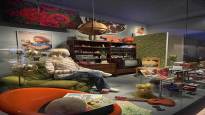Nordiska museet’s major exhibition has found its audience. The exhibition about the inhabitants of Pohjola is the largest in the museum’s history. It was done for five years.
STOCKHOLM Nordiska museet’s new major exhibition on the history of the inhabitants of the North has received enormous popularity. The Stockholm museum has extended its opening hours to shorten the queues.
From Malmö Christina Franzen came to the exhibition that opened in February, inspired by cultural news.
– It seemed exciting and somehow new in its way of thinking, Franzen justifies.
Curator Ulrika Torell confirms Franzen’s interpretation. According to Torelli, Nordiska museet organized themed exhibitions for a long time, but five years ago they started to outline a new large permanent exhibition about the inhabitants of Pohjola.
A large group of researchers was involved in the planning and the museum’s collections of one and a half million objects were used.
The end result is an exhibition on the entire top floor of the mighty museum building, with almost 4,000 objects in 27 rooms. The exhibition is the museum’s largest to date.
Forest Finns in Kustaa Vaasa’s favor
In the first hall of the exhibition, the familiar containers are surprising. Now we are in the 16th century, and the life of the forest Finns who moved from Savo to Sweden is on display.
According to Torelli, the Finns were in the favor of King Kustaa Vaasa, because they cultivated new farmland. Torell says that the local population, on the other hand, shunned forest Finns because they considered them to be wasters of natural resources.
Head of the Department of Cultural History Fredrik Svanberg reminds that the first 300 years of the exhibition, which spans from the 16th century to the present day, were lived in the time of joint Sweden-Finland.
– You could certainly make a Finnish path through the exhibition, if you wanted to.
A lot of new technology has been used in the exhibition. By clicking on the screens, you can delve into, for example, human destinies of different centuries. Thanks to the new technology, according to Svanberg, it is also possible to constantly increase the accumulated research data.
But the most exciting information is not necessarily found on the screens but in a traditional showcase. At least that’s what happened to a 17-year-old Siri to Kostela. What interested him the most was seeing what life had been like in his own parents’ childhood.
– Triangular milk cans used to look funny, but now they are square.
And near the milk cans, you can also find the character Reijo, who works at a chocolate factory, and represents the large Finnish immigrant group of the 1960s and 70s.
– Time passes nicely here. There are so many objects that you can’t stop at every place to wonder, because it would take you all day. But the exhibition is made with thought in mind, you can see that, says the Raisian The only Hallamurto.
– And it’s really nice to be here as a Finn, because our shared history is so long. In the 20th century, we have grown apart a bit [ruotsalaisista]but practically all the history of previous centuries is the history of our Finns at the same time, continues Aaro Hallamurto.
The public has found the exhibition so well that the museum has extended its weekday opening hours by one hour so that visitors’ time would not be wasted waiting in line. The extended opening hours are valid until the end of the summer.
